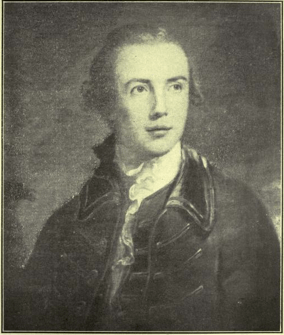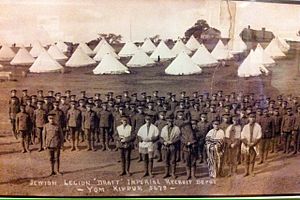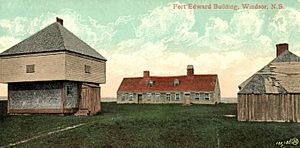Fort Edward (Nova Scotia) facts for kids
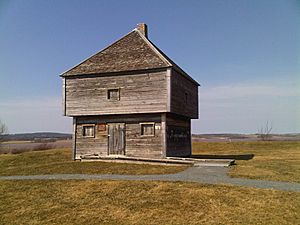 |
|
| Established | 1750 |
|---|---|
| Location | Windsor, Nova Scotia, Canada |
| Type | National Historic Site |
Fort Edward is a very old fort in Windsor, Nova Scotia, Canada. It's now a National Historic Site, which means it's a special place protected for its history. The British built this fort in 1750 during a time called Father Le Loutre's War. They wanted to stop the Acadians, who were French-speaking settlers, from leaving the area.
Fort Edward is famous for two main reasons. First, it played a big part in the Expulsion of the Acadians in 1755. Second, it helped protect Halifax, Nova Scotia, from attacks during the American Revolution. Most of the original fort is gone, but its blockhouse is the oldest one still standing in North America! A stone monument, called a cairn, was added later to the site.
Contents
Building Fort Edward: A Time of Conflict
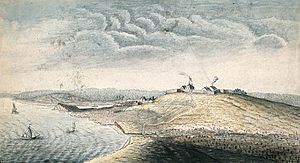
Even though the British took over Acadia (now Nova Scotia) in 1710, many French-speaking Acadians and Mi'kmaq people still lived there. A conflict known as Father Le Loutre's War began in 1749. This happened when Edward Cornwallis arrived to create Halifax, a new British settlement.
To protect their new towns from attacks by the Mi'kmaq, Acadians, and French, the British built several forts. These included forts in Halifax (1749), Bedford (called Fort Sackville) (1749), Dartmouth (1750), Lunenburg (1753), and Lawrencetown (1754).
Within a year and a half of starting Halifax, the British built forts in all the main Acadian areas. These included Windsor (Fort Edward), Grand Pré (Fort Vieux Logis), and Chignecto (Fort Lawrence). There was already a British fort, Fort Anne, in Annapolis Royal, Nova Scotia.
Fort Edward was built where an Acadian church once stood. In 1750, Major Charles Lawrence ordered the Acadians to destroy their church so the fort could be built. Before the fort was built, British soldiers called Rangers fought with the Mi'kmaq in the Battle at St. Croix in 1750. The fort was named by Captain John Gorham after Edward Cornwallis.
Fort Edward During the French and Indian War
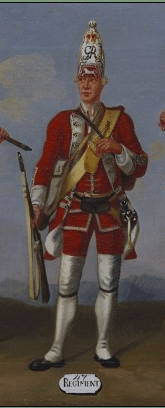
Fort Edward played a very important role in the Bay of Fundy Campaign (1755) during the Acadian Expulsion. This was a sad time when many Acadians were forced to leave their homes.
After a battle at Fort Beauséjour, Captain Alexander Murray, who was in charge of Fort Edward, wrote to his wife. He said the Acadians were very worried about what would happen to them. A month later, on September 5, 1755, Captain Murray read the expulsion order to 183 Acadian men he had gathered at Fort Edward.
On October 20, 920 Acadians from the Pisiquid area were put onto four ships. Unlike other Acadian communities, the British did not burn the houses and barns in Pisiquid. This meant that when new settlers, called New England Planters, arrived, many homes were ready for them. Fort Edward was one of four forts where Acadians were held prisoner during the nine years of the expulsion. On average, about 350 Acadian prisoners were kept at the fort at any one time.
Attacks on Fort Edward
The Acadians and Mi'kmaq did not give up easily. They fought back against the expulsion. In September 1756, about 100 Acadians attacked thirteen British soldiers working outside the fort. They captured seven soldiers, while six managed to escape back to the fort.
In April 1757, a group of Acadian and Mi'kmaq fighters raided a storage building near Fort Edward. They killed thirteen British soldiers and took supplies before setting the building on fire. A few days later, they also attacked Fort Cumberland.
A British officer named John Knox wrote that the British only "imagined" they controlled Nova Scotia in 1757. He said the situation was so dangerous that the soldiers and people at Fort Edward, Fort Sackville, and Lunenburg were like "prisoners" themselves.
In the early 1760s, it was against the law for Acadians to live in Nova Scotia. Families who had avoided capture in 1755 were later imprisoned. Records from Fort Edward show lists of Acadian prisoners from 1761-1762. One famous prisoner was Joseph Broussard, also known as Beausoleil. Between 1763 and 1764, British officials brought 363 Acadians to Fort Edward.
While imprisoned, Acadians were sometimes forced to work for the New England Planters on their farms. After the war ended, many Acadians chose to move to New Brunswick and Saint Pierre and Miquelon to be with other Acadians, rather than stay and work for others.
Notable Prisoners at Fort Edward
- Joseph Broussard (Beausoleil), a famous Acadian leader.
- Father Henri Daudin
- Father Jacques Girard
Commanders of Fort Edward
- Captain John Gorham (1750)
- Captain William Phipps (died 1751)
- Captain George St. Loe (military officer) (1751)
- Captain Patrick Sutherland (1751)
- Captain John Hale (1753)
- Captain Matthew Floyer (1753–54)
- Captain Nicholas Cox (1754–56)
- Captain Alexander Murray (1754–55)
- Colonel Quintin Kennedy (1757)
- Captain Daniel Fletcher (military officer) (1758–59)
- Captain Jotham Gay (1759-1760, 1760-1761)
- Captain Edmund Wetmough (1760)
Gallery of Commanders
Fort Edward in the American Revolution
During the American Revolution, soldiers from the 84th Regiment of Foot (Royal Highland Emigrants) were stationed at forts across Atlantic Canada. Fort Edward became the main base for the 84th Regiment in this region. The soldiers moved from Halifax to Fort Edward to protect against any attacks on Halifax by land. Throughout the war, Fort Edward also held prisoners captured from American privateering ships.
A famous Scottish woman named Flora MacDonald stayed at the fort with her husband during the winter of 1778-1779 before she returned to Scotland.
War of 1812 and Beyond
Fort Edward was also used during the War of 1812. It continued to help protect Nova Scotia from attacks by American privateers. The fort remained an important part of British defenses in Nova Scotia until 1858.
Fort Edward in World War I
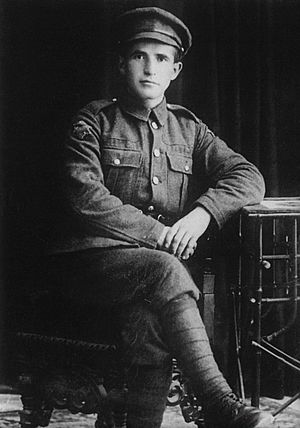
During World War I, Fort Edward became a training camp for Canadian and British soldiers. It was informally known as "Camp Fort Edward." One of the recruits who trained there was William Desmond Taylor, who later became a Hollywood film director.
The British Army also used the fort to train Jewish men who volunteered to fight against the Ottoman Turks in Palestine. This unit was called The Jewish Legion. About 1100 Jewish troops, led by Lt Colonel Eliezer Margolin, trained at Fort Edward in 1917. Many of these recruits had dreams of a Jewish homeland in Palestine.
Important leaders like David Ben-Gurion, who became the first prime minister of Israel, and Ze'ev Jabotinsky both trained at Fort Edward. David Ben-Gurion, when he was 70 years old, remembered his time at Fort Edward, saying he would "never forget Windsor where I received my first training as a soldier and where I became a corporal."
Fort Edward National Historic Site Today
Fort Edward was officially named a National Historic Site in 1920. The blockhouse, which is the oldest part of the fort still standing, was also recognized as a special heritage building in 1994.
Windsor Agricultural Fair
The Windsor Agricultural Fair is the oldest continuous agricultural fair in North America. It started with the first generation of New England Planters at Fort Edward in 1765.
See also
 In Spanish: Fort Edward para niños
In Spanish: Fort Edward para niños
- List of oldest buildings in Canada
- Military history of Nova Scotia
- Military history of the Mi'kmaq people
- Military history of the Acadians


